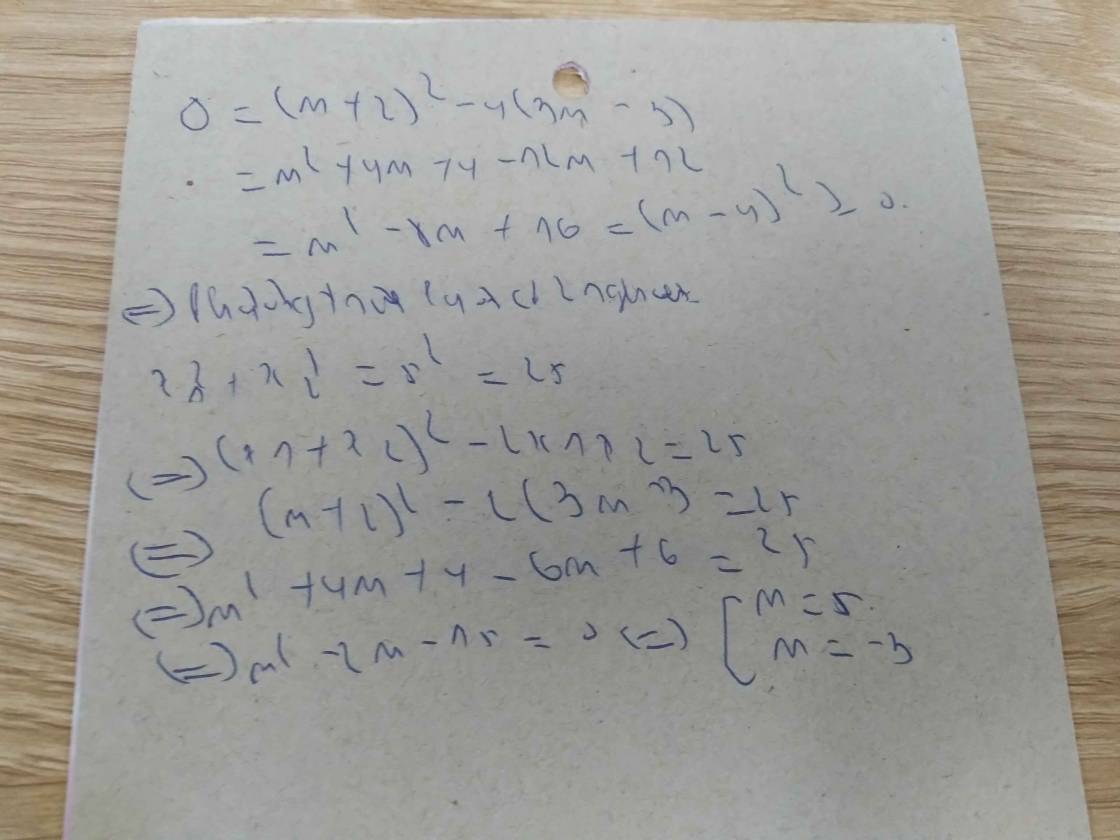Hãy nhập câu hỏi của bạn vào đây, nếu là tài khoản VIP, bạn sẽ được ưu tiên trả lời.

Vì phương trình có 2 nghiệm phân biệt \(x_1,x_2\) nên theo hệ thức VI-ét ta có:
\(\left\{{}\begin{matrix}x_1+x_2=m+5\\x_1x_2=3m+6\end{matrix}\right.\)
Mà \(x_1,x_2\) là độ dài của hai cạnh góc vuông của một tam giác vuông có độ dài cạnh huyền bằng 5 nên ta có:\(\Rightarrow x_1^2+x_2^2=25\Rightarrow\left(x_1+x_2\right)^2-2x_1x_2=25\Rightarrow\left(m+5\right)^2-2\left(3m+6\right)=25\Leftrightarrow m^2+10m+25-6m-12=25\Leftrightarrow m^2+4m-12=0\Leftrightarrow m^2-2m+6m-12=0\Leftrightarrow\left(m-2\right)\left(m+6\right)=0\Leftrightarrow\left[{}\begin{matrix}m=2\\m=-6\end{matrix}\right.\) b Vì phương trình có 2 nghiệm phân biệt \(x_1,x_2\) nên theo hệ thức Vi-ét ta có:
\(\left\{{}\begin{matrix}x_1+x_2=2m-6\\x_1x_2=2m-2\end{matrix}\right.\) \(\Rightarrow T=\left(x_1+x_2\right)^2-2x_1x_2=\left(2m-6\right)^2-2\left(2m-2\right)=4m^2-24m+36-4m+4=4m^2-28m+40=4m^2-28m+49-9=\left(2m-7\right)^2-9\ge-9\) Dấu = xảy ra \(\Leftrightarrow m=\dfrac{7}{2}\)

\(\Delta=\left(m+5\right)^2-4\left(3m+6\right)=m^2-2m+1=\left(m-1\right)^2\ge0\) ;\(\forall m\)
\(\Rightarrow\) Phương trình luôn có 2 nghiệm với mọi m
Theo hệ thức Viet: \(\left\{{}\begin{matrix}x_1+x_2=m+5\\x_1x_2=3m+6\end{matrix}\right.\)
Do \(x_1;x_2\) là độ dài 2 cạnh tam giác nên \(x_1>0;x_2>0\)
\(\Rightarrow\left\{{}\begin{matrix}m+5>0\\3m+6>0\end{matrix}\right.\) \(\Rightarrow m>-2\)
Khi đó, áp dụng định lý Pitago:
\(x_1^2+x_2^2=5^2\)
\(\Leftrightarrow\left(x_1+x_2\right)^2-2x_1x_2=25\)
\(\Leftrightarrow\left(m+5\right)^2-2\left(3m+6\right)=25\)
\(\Leftrightarrow m^2+4m-12=0\Rightarrow\left[{}\begin{matrix}m=-6< -2\left(loại\right)\\m=2\end{matrix}\right.\)

Để phương trình có 2 nghiệm:
\(\Delta\ge0\Rightarrow\left[-\left(m+2\right)\right]^2-4.1.\left(3m-3\right)\ge0\\ \Leftrightarrow m^2+4m+4-12m+12\ge0\\ \Leftrightarrow m^2-8m+16\ge0\forall m\)
Theo Vi-et ta có: \(\left\{{}\begin{matrix}x_1+x_2=\dfrac{-\left[-\left(m+2\right)\right]}{1}=m+2\\x_1.x_2=\dfrac{3m-3}{1}=3m-3\end{matrix}\right.\)
x1, x2 là độ dài của một giam giác vuông có cạnh huyền bằng 5.
Theo định lý Py-ta-go ta có:
\(x_1^2+x_2^2=5^2\Leftrightarrow x_1^2+2x_1x_2+x_2^2-2x_1x_2=25\\ \Leftrightarrow\left(x_1+x_2\right)^2-2x_1x_2=25\\ \Leftrightarrow\left(m+2\right)^2-2.\left(3m-3\right)=25\\ \Leftrightarrow m^2+4m+4-6m+6-25=0\\ \Leftrightarrow m^2-2m-15=0\Leftrightarrow\left[{}\begin{matrix}m=5\\m=-3\end{matrix}\right.\)
Vậy...

Để phương trình có nghiệm
\(\Delta'=\left(-m\right)^2-1.\left(m^2-\dfrac{1}{2}\right)\ge0\Leftrightarrow\dfrac{1}{2}\ge0\) ( luôn đúng)
Áp dụng vi.et có
\(\left\{{}\begin{matrix}x_1+x_2=2m\\x_1x_2=m^2-\dfrac{1}{2}\end{matrix}\right.\)
Theo bài ra ta có
\(x_1^2+x_2^2=9\)
\(\Leftrightarrow\left(x_1+x_2\right)^2-2x_1x_2=9\)
\(\Leftrightarrow\left(2m\right)^2-2\left(m^2-\dfrac{1}{2}\right)=9\)
\(\Leftrightarrow4m^2-2m^2+1=9\)
\(\Leftrightarrow2m^2=8\Leftrightarrow m^2=4\Leftrightarrow m=\pm2\)
Để pt có nghiệm <=> \(\Delta'\ge0\Leftrightarrow\left(-m\right)^2-1\left(m^2-\dfrac{1}{2}\right)\ge0\)
\(\Leftrightarrow m^2-m^2+\dfrac{1}{2}\ge0\Leftrightarrow\dfrac{1}{2}\ge0\) (Đúng)
Vậy pt luôn có 2 nghiệm x1,x2
Theo hệ thức vi-et, ta có: \(\left\{{}\begin{matrix}x_1+x_2=2m\\x_1x_2=m^2-\dfrac{1}{2}\end{matrix}\right.\)
Ta có: \(x_1^2+x_2^2=3^2=9\)
<=>\(\left(x_1+x_2\right)^2-2x_1x_2=9\)
<=>(2m)2-2(m2-1/2)=9
<=>4m2-2m2+1=9
<=>2m2=8<=>m2=4<=>\(m=\pm2\)

Đề là \(x^2-\left(m+5\right)x+3m+6=0\) đúng không nhỉ?
a. Ta có:
\(\Delta=\left(m+5\right)^2-4\left(3m+6\right)=m^2-2m+1=\left(m-1\right)^2\ge0\) ; \(\forall m\)
\(\Rightarrow\) Phương trình đã cho luôn có 2 nghiệm với mọi m
b. Theo hệ thức Viet: \(\left\{{}\begin{matrix}x_1+x_2=m+5\\x_1x_2=3m+6\end{matrix}\right.\)
Để \(x_1;x_2\) là độ dài 2 cạnh góc vuông thì trước hết \(x_1;x_2\) dương
\(\Rightarrow\left\{{}\begin{matrix}x_1+x_2>0\\x_1x_2>0\end{matrix}\right.\) \(\Rightarrow\left\{{}\begin{matrix}m+5>0\\3m+6>0\end{matrix}\right.\) \(\Rightarrow m>-2\)
Khi đó áp dụng định lý Pitago:
\(x_1^2+x_2^2=25\Leftrightarrow\left(x_1+x_2\right)^2-2x_1x_2=25\)
\(\Leftrightarrow\left(m+5\right)^2-2\left(3m+6\right)=25\)
\(\Leftrightarrow m^2+6m-12=0\Rightarrow\left[{}\begin{matrix}m=-3-\sqrt{21}< -2\left(loại\right)\\m=-3+\sqrt{21}\end{matrix}\right.\)

\(\Delta=\left(m+4\right)^2-4\left(3m+3\right)=m^2-4m+4=\left(m-2\right)^2\ge0\) ; \(\forall m\)
\(\Rightarrow\) Phương trình đã cho luôn có nghiệm với mọi m
Theo hệ thức Viet: \(\left\{{}\begin{matrix}x_1+x_2=m+4\\x_1x_2=3m+3\end{matrix}\right.\)
\(x_1^2-x_1=x_2-x_2^2+8\)
\(\Leftrightarrow x_1^2+x_2^2-\left(x_1+x_2\right)-8=0\)
\(\Leftrightarrow\left(x_1+x_2\right)^2-2x_1x_2-\left(x_1+x_2\right)-8=0\)
\(\Leftrightarrow\left(m+4\right)^2-2\left(3m+3\right)-\left(m+4\right)-8=0\)
\(\Leftrightarrow m^2+m-2=0\Rightarrow\left[{}\begin{matrix}m=1\\m=-2\end{matrix}\right.\)

a, Thay m = 1 vào phương trình trên ta được
phương trình có dạng : \(x^2-3x=0\Leftrightarrow x\left(x-3\right)=0\Leftrightarrow x=0;x=3\)
b, Để phương trình có nghiệm kép \(\Delta=0\)
\(\Delta=9-4\left(m-1\right)=9-4m+4=0\Leftrightarrow13-4m=0\Leftrightarrow m=\frac{13}{4}\)
c, Để 2 nghiệm của pt là độ dài hcn khi 2 nghiệm đều dương
\(\hept{\begin{cases}\Delta=9-4\left(m+1\right)>0\\x_1+x_2=-\frac{b}{a}=3>0\\x_1x_2=\frac{c}{a}=m-1>0\end{cases}\Leftrightarrow1< m< \frac{13}{4}}\)
Diện tích hình chữ nhật là : \(x_1x_2=2\Leftrightarrow m-1=2\Leftrightarrow m=3\)( tmđk )

Lời giải:
Để pt có 2 nghiệm pb thì:
$\Delta'=1-(2-m)=m-1>0\Leftrightarrow m>1$
Áp dụng định lý Viet: \(\left\{\begin{matrix} x_1+x_2=2\\ x_1x_2=2-m\end{matrix}\right.\)
Khi đó:
$2x_1^3+(m+2)x_2^2=5$
$\Leftrightarrow 2x_1^3+(2x_1+2x_2-x_1x_2)x_2^2=5$
$\Leftrightarrow 2(x_1^3+x_2^3)+x_1(2-x_2)x_2^2=5$
\(\Leftrightarrow 2[(x_1+x_2)^3-3x_1x_2(x_1+x_2)]+x_1^2x_2^2=5\)
\(\Leftrightarrow 2[8-6(2-m)]+(2-m)^2=5\)
\(\Leftrightarrow m^2+8m-9=0\Leftrightarrow (m-1)(m+9)=0\)
Vì $m>1$ nên không có giá trị nào của $m$ thỏa mãn.

a, Ta có:
\(\Delta=\left[-\left(m+5\right)\right]^2-4\left(2m+6\right)\\ =m^2+10m+25-8m-24\\ =m^2+2m+1\\ =\left(m+1\right)^2\ge0\)
Vậy pt luôn có 2 nghiệm x1,x2
b, Theo Vi-ét:\(\left\{{}\begin{matrix}x_1+x_2=m+5\\x_1x_2=2m+6\end{matrix}\right.\)
\(x^2_1+x^2_2=13\\ \Leftrightarrow\left(x_1+x_2\right)^2-2x_1x_2=13\\ \Leftrightarrow\left(m+5\right)^2-2\left(2m+6\right)=13\\ \Leftrightarrow m^2+10m+25-4m-12-13=0\\ \Leftrightarrow m^2+6m=0\\ \Leftrightarrow m\left(m+6\right)=0\\ \Leftrightarrow\left[{}\begin{matrix}m=0\\m=-6\end{matrix}\right.\)

Đầu tiên đi tính \(\Delta\) gỉai ra ta dc
=> m\(\ne\)1
Với m\(\ne\)1 => pt 1 có 2 nghiệm phân biệt x1 x2
=> theo hệ thức Vi ét ta dc
\(\left\{{}\begin{matrix}x1+x2=m+5\\x1x2=3m+6\end{matrix}\right.\) *
Vì x1, x2 là chiều dài và chiều rộng của một hình chữ nhật có độ dài đường cao bằng 5.
=> ta có hệ thức
\(\dfrac{1}{5^2}=\dfrac{1}{x_1^2}+\dfrac{1}{x_2^2}\)
Biên đổi và thay vi ét vào là dc